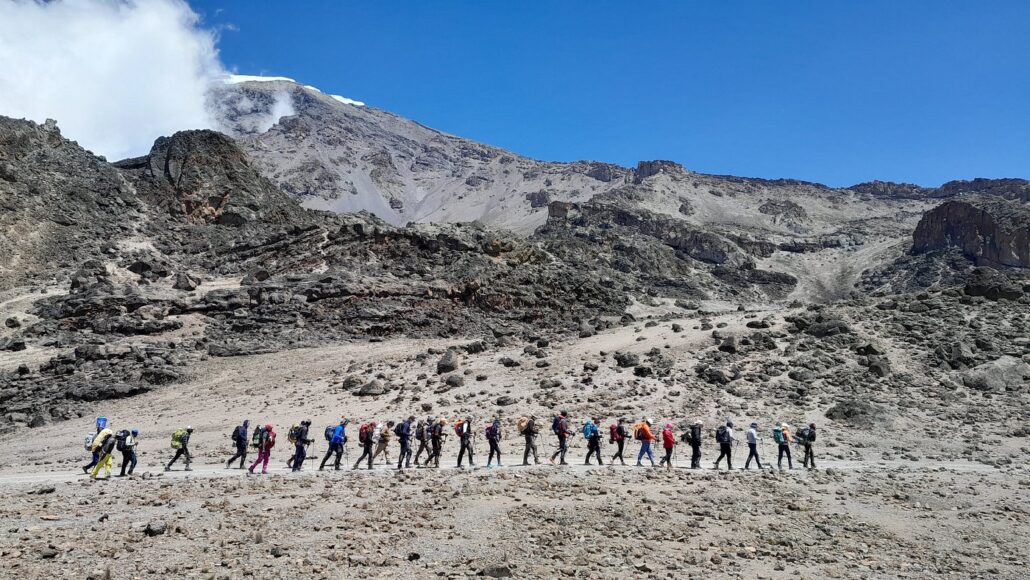Lemosho Route Of Mount Kilimanjaro
Lemosho Kilimanjaro Climbing route stands out for its scenic beauty, rich biodiversity, and high success rate. The Kilimanjaro Lemosho Route is widely regarded as one of the most picturesque route to Kilimanjaro’s summit. Starting on the western side of the mountain, it traverses through diverse ecosystems, from lush rain forests to arid highlands. This route merges with the Machame Route before approaching the Shira Plateau, offering trekkers a varied and enriching journey.
This detailed guide explores the nuances of the Lemosho Route, providing insights into its advantages, challenges, and the overall trekking experience.
Key Features Of Lemosho Route Of Mount Kilimanjaro
- Route Length: Approximately 70 kilometers (43.5 miles)
- Duration: Typically 7 to 9 days
- Difficulty: Moderate to high
- Success Rate: Around 90% for 8-day treks
7 Days Mount Kilimanjaro Trekking Lemosho Route
Day 1: Londorossi Gate to Mti Mkubwa (Big Tree Camp)
- Elevation: 2,360 meters (7,742 feet) to 2,820 meters (9,252 feet)
- Distance: 6 km (3.7 miles)
- Duration: 3-4 hours
Trekkers begin their journey at Londorossi Gate, where registration and permits are processed. The initial trek leads through the dense, wildlife-rich rain forest to Mti Mkubwa (Big Tree Camp).
Day 2: Mti Mkubwa to Shira 1 Camp
- Elevation: 2,820 meters (9,252 feet) to 3,610 meters (11,843 feet)
- Distance: 8 km (5 miles)
- Duration: 5-6 hours
The second day involves a steady climb through moorland, providing stunning views of the Shira Plateau. The trek ends at Shira 1 Camp, located on the western edge of the plateau.
Day 3: Shira 1 Camp to Shira 2 Camp
- Elevation: 3,610 meters (11,843 feet) to 3,850 meters (12,631 feet)
- Distance: 7 km (4.3 miles)
- Duration: 3-4 hours
A relatively short trek, this day allows for acclimatization while crossing the Shira Plateau. The camp at Shira 2 offers expansive views of the Kibo summit and surrounding landscape.
Day 4: Shira 2 Camp to Barranco Camp via Lava Tower
- Elevation: 3,850 meters (12,631 feet) to 3,900 meters (12,795 feet)
- Distance: 10 km (6.2 miles)
- Duration: 6-8 hours
This challenging day includes a climb to Lava Tower at 4,640 meters (15,223 feet), followed by a descent to Barranco Camp. The ascent and descent help with acclimatization, making the trek easier in the following days.

Day 5: Barranco Camp to Karanga Camp
- Elevation: 3,900 meters (12,795 feet) to 3,995 meters (13,106 feet)
- Distance: 5 km (3.1 miles)
- Duration: 4-5 hours
The trek starts with the Barranco Wall, a steep but manageable scramble. The path then undulates through valleys before reaching Karanga Camp, providing stunning views and a crucial acclimatization opportunity.
Day 6: Karanga Camp to Barafu Camp
- Elevation: 3,995 meters (13,106 feet) to 4,673 meters (15,331 feet)
- Distance: 4 km (2.5 miles)
- Duration: 3-4 hours
A short but steep trek leads to Barafu Camp, the base camp for the summit attempt. Trekkers rest and prepare for the final ascent, which begins around midnight.
Day 7: Barafu Camp to Uhuru Peak, then descent to Mweka Camp
- Elevation (Ascent): 4,673 meters (15,331 feet) to 5,895 meters (19,341 feet)
- Elevation (Descent): 5,895 meters (19,341 feet) to 3,068 meters (10,065 feet)
- Distance (Total): 17 km (10.6 miles)
- Duration: 12-15 hours
The summit push begins early, aiming to reach Uhuru Peak at sunrise. After celebrating at the summit, trekkers descend to Barafu Camp for a short rest, then continue down to Mweka Camp.
Day 8: Mweka Camp to Mweka Gate
- Elevation: 3,068 meters (10,065 feet) to 1,640 meters (5,381 feet)
- Distance: 10 km (6.2 miles)
- Duration: 3-4 hours
The final descent passes through lush rainforest to Mweka Gate, where successful trekkers receive their certificates.
Benefits of the Lemosho Route
- Scenic Diversity: The route offers an unparalleled variety of landscapes, including rainforest, moorland, alpine desert, and the Arctic-like summit zone.
- Acclimatization Advantage: With its longer duration, the Lemosho Route provides better opportunities for acclimatization, reducing the risk of altitude sickness.
- Less Crowded: Compared to the popular Marangu and Machame routes, Lemosho is less trafficked, offering a more serene trekking experience.
- High Success Rate: The combination of gradual ascent and longer itinerary contributes to a high summit success rate.
Challenges and Considerations
- Physical Demands: Despite its advantages, the Lemosho Route is physically demanding, requiring trekkers to be in good shape.
- Weather Variability: Kilimanjaro’s weather is unpredictable, with conditions changing rapidly. Proper gear for both extreme cold and wet conditions is essential.
- Altitude Sickness: Even with good acclimatization, altitude sickness can affect anyone. Trekkers should be aware of symptoms and prepared to descend if necessary.